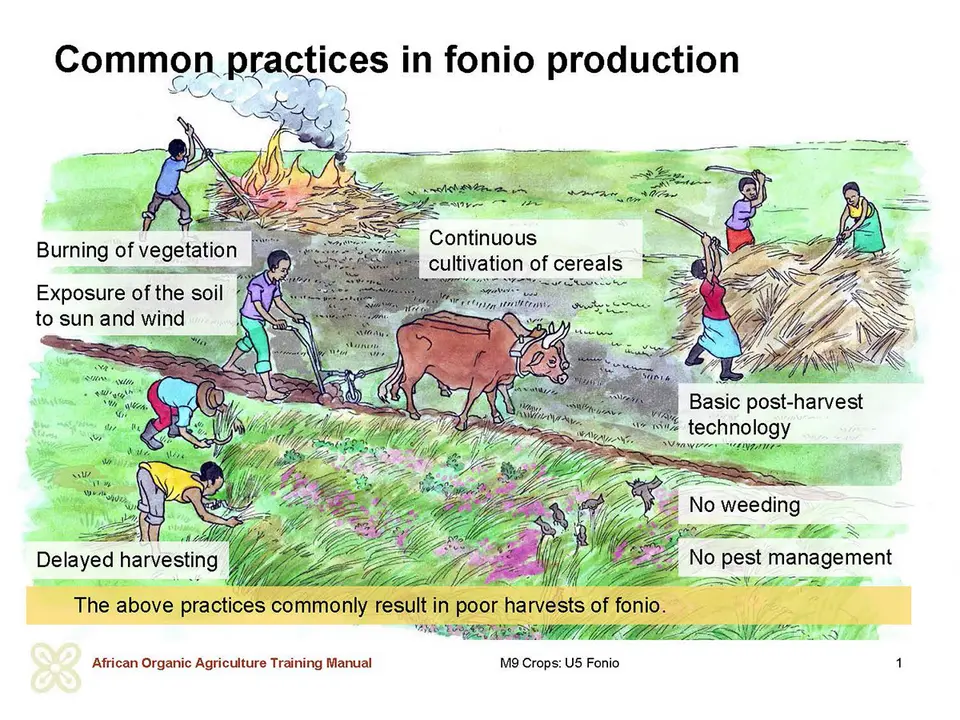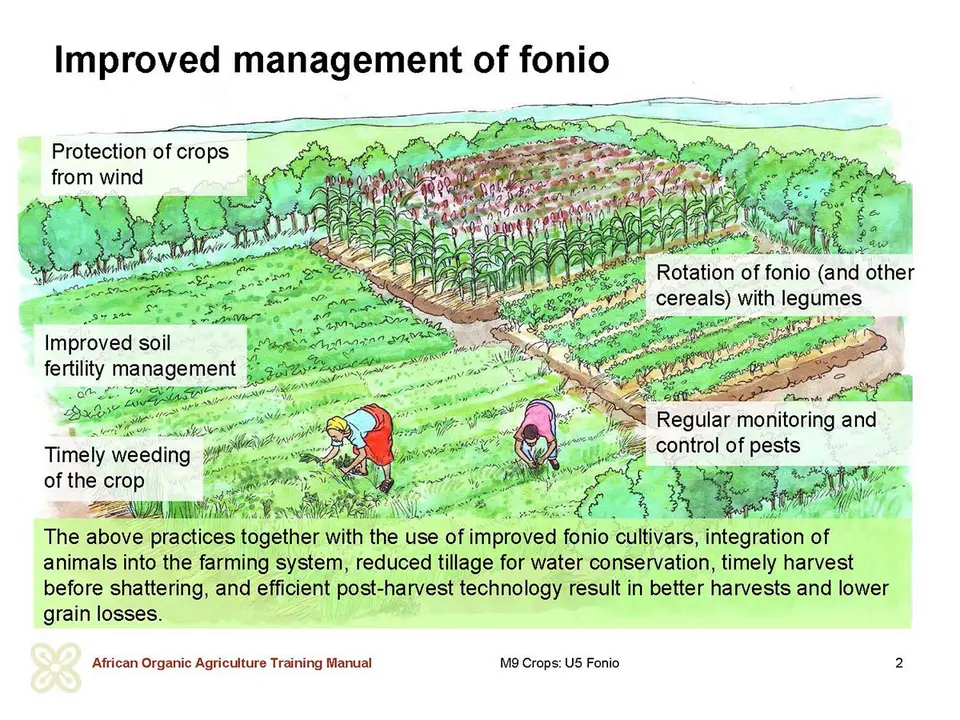Introduction
White Fonio (Digitaria exilis), also known as ‘acha’ or ‘fundi’, is a minor cereal crop cultivated throughout West Africa from Senegal to Lake Chad. It is a common staple food as well as a prestige food and a gourmet item. The plants, reaching a size of 30 to 80 cm, produce tiny grains of 1.0 to 1.5 mm length which have excellent nutritional quality and are also a valuable, easily digested feed for poultry. The straw and the chaff are excellent fodder and are often sold in West African markets. The straw is also chopped and mixed with clay to build walls of houses, or used as fuel for cooking or to produce ash for potash.
Fonio is a source of food for several million people when other food resources are scarce, making an essential contribution to food security. Due to its short growth cycle of 70 to 150 days, farmers can sow the crop two times within one year, if conditions allow. If farmers grow cultivars with a very short cycle, fonio enables them to cover the critical season before the major food crops are harvested.
Fonio grows on very poor soils, where other cereals do not succeed. But its low yielding capacity and very laborious traditional processing have hindered its development
Fonio production faces several challenges:
- Poor soil fertility: One reason for low yields, which have been attributed to the crop, is that fonio is mostly grown on poor sandy soils that are considered too infertile for other cereals. Fonio has a very low nutrient demand, and therefore generally occupies the last place in rotation systems before a fallow of several years. Provision of nutrients and water is usually not thought to be relevant by the farmers. For soil preparation many farmers burn the fallow vegetation and spread the ashes. This procedure destroys soil organic matter in the topsoil, which is essential for soil fertility and soil moisture conservation.
- Use of low-yielding cultivars: Fonio cultivation relies mainly on traditional landraces. Thus, farmers use seeds from the previous harvest to grow the new crop. Traditional landraces are often less productive than the few existing improved varieties, despite their good adaptation to marginal growing conditions.
- Inadequate weeding: Due to fonio’s ability to establish quickly, farmers normally do not weed the fields. This leaves the crop to compete with weeds, which can reduce its ability to yield well.
- Pests and diseases: Susceptibility of fonio to pests and diseases is low. Nevertheless, some fungi can affect the growing crop. Grain moulds are also common. The parasitic Striga weed, particularly Striga rowlandi which is known to occur abundantly in West Africa, can cause serious damage to the crop. Insect pests can also cause significant losses; birds feed on the maturing grains.
- High harvest losses and laborious post-harvest management: Lodging and shattering of seeds result in high grain losses. Lodging of fonio is common because of the fragile nature of its shoots. Shattering of seeds in mature crops is another problem. In delayed harvests grain losses can reach 25 percent. Threshing and husking are a labour-intensive task and are difficult to perform. They are traditionally performed manually by beating or trampling on the fonio sheaves, often on unpaved flat ground or rocks, which results in contamination of the product with sand.
- Low socio-economic appraisal: Fonio has a low ranking in regional cereal production due to its low yields and rather low commercial value. This makes it less competitive than other cereals like pearl millet, sorghum or maize and hampers its improvement. So far, plant breeders have contributed little to provide improved cultivars.
Despite all the constraints, total fonio production in West Africa has increased steadily since 1980, mainly due to an increase of the harvested area. However, considerable potential for improvement remains in both production and processing. Further improvement depends on better cultivars, improved crop management, and less laborious processing methods.
Discussion: Assessment of the fonio production situation
Inquire about the status of fonio production in the area, using the following questions:
- Is fonio a common crop in the area?
- Under what conditions is it commonly grown?
- What are the average yields?
- Which attention is given to the crop?
- Which are considered to be the main constraints to good fonio yields?
Discussion on potential improvements in fonio production
Discuss with the farmers potential improvements in fonio production based on prevailing challenges:
- How can crop growth and yields be improved?
- How can harvest and post-harvest losses be reduced?
- How can processing be simplified?


 tap and then scroll down to the Add to Home Screen command.
tap and then scroll down to the Add to Home Screen command.